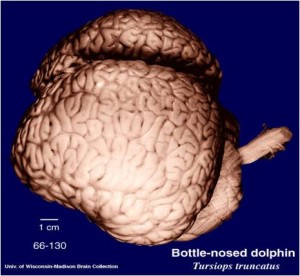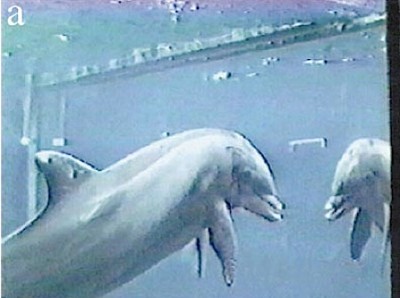They’re Super-Brainy, Too!
Their brains are every bit as complex as our own
Dolphins and UsPart One: The Smartest of Us All? “So Long, and Thanks for All the Fish!” Amazing Abilities of Dolphins Dolphins or Humans: Who’s Smarter? Dolphin Society and Culture They’re Super-Brainy, Too More Fascinating Stuff The Great Researcher A Society that Works Are Dolphins “Persons” Life and Culture How Smart is a Dolphin? Experimenting on Dolphins My Visit to the Dolphins Other Links & Videos Mirror Self-Recognition Test The Herman Investigation The Minds of Whales |
Another way we can learn about dolphin intelligence is by studying the brains of dolphins.
Lori Marino is a professor of neuroscience and behavioral biology, and she knows more about dolphin brains than anyone. (She only studies the brains of dolphins who have died a natural death.)
 When she compares the brains of dolphins and humans, she sees that the part of the brain (the neocortex) that’s responsible for advanced intelligence and self-awareness is at least as developed in dolphins as it is in humans.
When she compares the brains of dolphins and humans, she sees that the part of the brain (the neocortex) that’s responsible for advanced intelligence and self-awareness is at least as developed in dolphins as it is in humans.
It’s different, of course, but one thing that fascinates her is how dolphins and humans, who evolved in hugely different environments over millions of years, have ended up sharing a whole lot in common, and are able to communicate with each other remarkably well.
Lori won’t go as far as to say whether we or they are the more intelligent. (On what basis would we even decide that?) But you can’t help but get the impression that she thinks they’re the super-smart ones.
Lori Marino also helped devise the renowned mirror-self-recognition test for dolphins. Recognizing yourself in a mirror is quite an advanced form of consciousness. It involves understanding that the person you’re looking at is really you. Human children can’t do it for the first two years of their life. (Try it if you have a baby … you’ll see that they just don’t get that the baby in the mirror is them.) Chimps get it; so do elephants; and magpies are the latest animals to pass the test, which usually involves painting a mark on, say, their forehead, and seeing how they respond when they see themselves again in the mirror. Do they touch the mark on their own forehead? If so, then, yes, they get it.
 Lori tried this out with a colleague on some dolphins at the New York Aquarium. First, they installed a big mirror underwater in the dolphin tank. The dolphins were obviously fascinated by this, and spent time gazing at themselves. Then the aquarium staff painted a mark on the dolphins’ stomachs, and Lori’s team watched to see what happened next. As soon as the dolphins saw the mark in the mirror, they started twisting and turning to see it better and touching it with their flippers. Test passed!
Lori tried this out with a colleague on some dolphins at the New York Aquarium. First, they installed a big mirror underwater in the dolphin tank. The dolphins were obviously fascinated by this, and spent time gazing at themselves. Then the aquarium staff painted a mark on the dolphins’ stomachs, and Lori’s team watched to see what happened next. As soon as the dolphins saw the mark in the mirror, they started twisting and turning to see it better and touching it with their flippers. Test passed!
(It was after that, by the way, that Lori concluded that keeping dolphins in captivity is completely wrong. She’s been campaigning against it ever since, and has co-founded a new organization, the Aurelia Center for Animals and Cultural Change, to bring science and education to bear on how we treat non-human animals.)
So should we be doing research on dolphins in captivity?
One of the other scientists who took part in the mirror test is still doing experiments with captive dolphins. Diana Reiss is the head of marine mammal research at the National Aquarium, and we wanted to get a sense from her what value there is, these days, in studying dolphins in captivity, and whether or when it should be brought to an end. It was, frankly, a rather unsatisfying interview, where most of the answers were simply “I don’t know” or even “Please don’t ask me.”
And later, Dr. Reiss said she wanted to edit the interview in case it might upset the people at SeaWorld and the rest of the captivity industry who profit from exploiting dolphins. When we questioned her on this, she asked that we not publish any of her remarks!
But scientists need to be accountable for what they’re doing to animals, so here’s the interview anyway.
One person who thinks we can learn more from dolphins in the wild than we ever can from dolphins in captivity is Howard Garrett, who runs the Orca Network. Orcas, or “killer whales”, are the largest species of dolphin. Howard doesn’t believe anything useful can be learned from dolphins in captivity. But he goes a step further and says that there are dolphins in the wild who would be quite willing to visit with scientists who take the time to go visit them in the ocean and study their language, culture and societies.
Read our interview with Howard Garrett about how we can learn from dolphins in the wild.
Howard has also been campaigning since 1995 to have one particular orca, Lolita, set free from the Miami Seaquarium where she’s been held captive for more than 40 years. So we’ll come back to him when we talk about the dolphin entertainment industry.
~~~~~~~~~~~~~~~~~~~~
This completes Part One of our feature. Check out all the side links on the right if you’d like more background.
Next, we look at how dolphins have become exploited for entertainment and other business. And then we’ll look at how moves are underway to bring an end to that exploitation and have dolphins declared to be “persons” in their own right.
